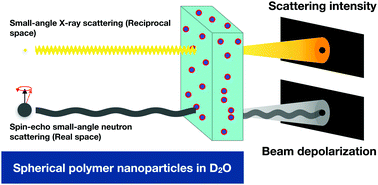Spin-echo small-angle neutron scattering (SESANS) studies of diblock copolymer nanoparticles†
Abstract
Poly(glycerol monomethacrylate)–poly(benzyl methacrylate) (PGMA–PBzMA) diblock copolymer nanoparticles were synthesized via polymerization-induced self-assembly (PISA) using reversible addition–fragmentation chain-transfer (RAFT) aqueous emulsion polymerization in D2O. Such PISA syntheses produce sterically-stabilized nanoparticles in situ and can be performed at relatively high copolymer concentrations (up to 50 wt%). This PGMA–PBzMA formulation is known to form only spherical nanoparticles in water using aqueous emulsion polymerization (Macromolecules, 2014, 47, 5613–5623), which makes it an ideal model system for exploring new characterization methods. The polymer micelles were characterized using small-angle X-ray scattering (SAXS) and a recently developed form of neutron scattering, spin-echo small-angle neutron scattering (SESANS). As far as we are aware, this is the first report of a study of polymer micelles by SESANS, and the data agree well with reciprocal-space scattering. Using this technique enables characterization of the concentrated, as synthesized dispersions directly without dilution, and this will provide a method to study self-assembled polymer systems that have concentration dependent morphologies, while still maintaining the advantages of scattering techniques.



 Please wait while we load your content...
Please wait while we load your content...